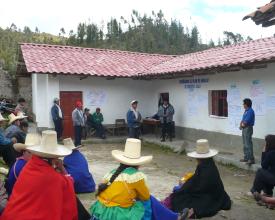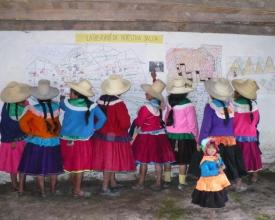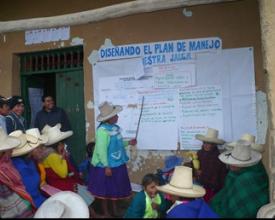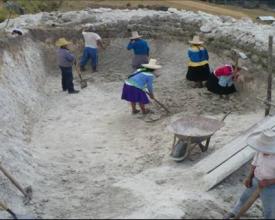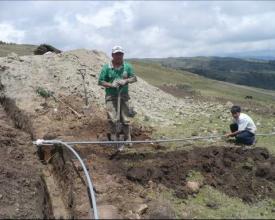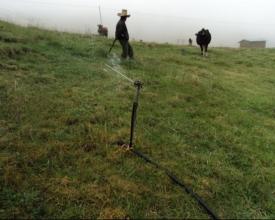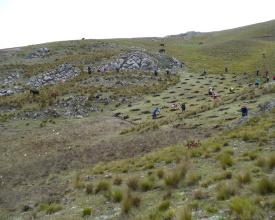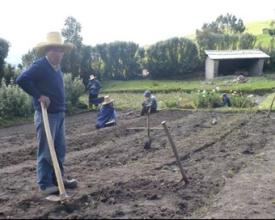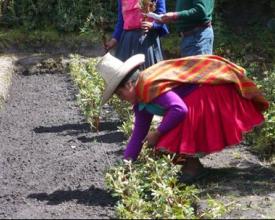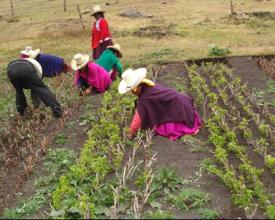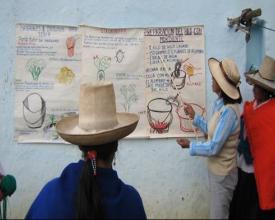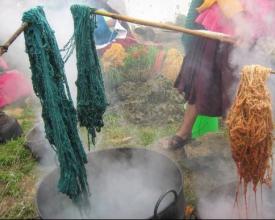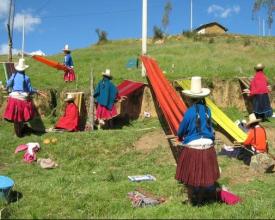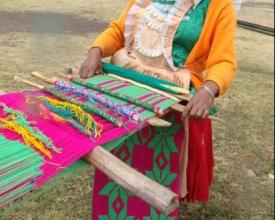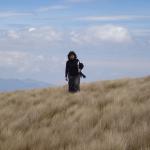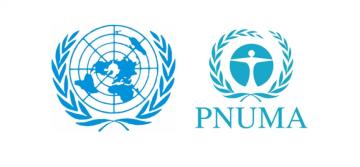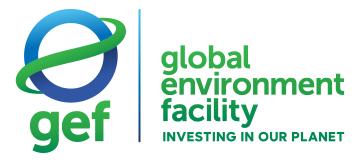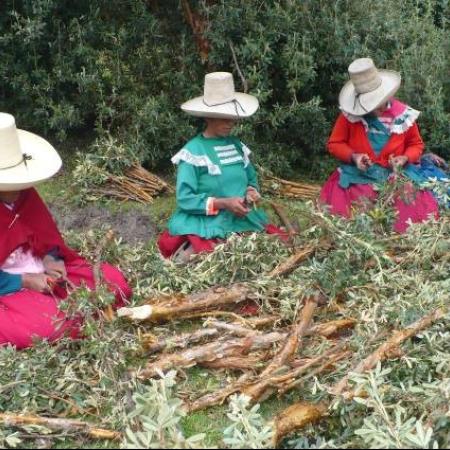
Integrating Jalca Ecosystem Conservation into Local Planning to Secure Water Supply
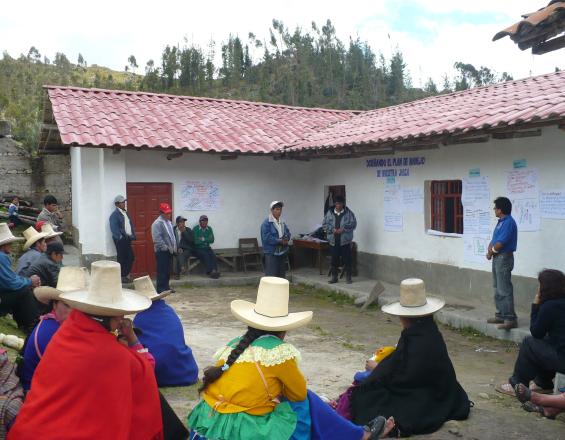
In recent decades, the Jalca, an important high Andean ecosystem for water regulation, has been threatened by poor management and changes in precipitation associated with climate change. In response to this, the Andean Paramo Project promoted the conservation of the Jalca as a water source, working with the population on a participatory management plan, which prioritized measures to conserve the ecosystem and to make better use of water, which together contribute to climate change adaptation. Among the measures are: protection of water sources and springs with queñual (Polylepis spp.) plantations and stone walls; agroforestry, forest nurseries and afforestation with queñual in thickets and protection of meadows with live fences; construction of micro-reservoirs and installation of sprinkler irrigation. These measures were collected and financed by local governments and taken into account by the regional government to determine conservation priorities.
Context
Challenges addressed
The Jalca is of great value for its cultural and biological diversity, as well as for the hydrological services it provides. However, it faces strong threats such as increased agriculture, overgrazing, periodic fires in the grasslands, forestation with exotic species, and, more recently, open-pit mining, which occupies large areas and uses enormous volumes of water. Added to this are the effects of climate change, such as frosts, changes in the precipitation regime, which is manifested in periods of drought and intense rainfall. All this has generated less water availability for human consumption, for agricultural activities and for pasture and livestock production.
The implementation of collective planning at the communal level and its subsequent articulation at higher territorial scales has also been an enormous challenge. The measure has required retaking the culture of collective work and unpaid reciprocal help, which is gradually being lost.
Location
Process
Summary of the process
In the Participatory Management Plan for the micro-watershed (BB1), the community members and residents identified and prioritized natural resource management practices focused on solving the problem of water scarcity identified as the community's main concern. The measures contributed to both securing water supply and reducing demand, such as:
- Water harvesting in micro-reservoirs and sprinkler irrigation (BB2).
- Protection of meadows, water springs and springs by live fences of native plantations and stone walls (BB3).
- Native plant nurseries and forestry (BB3)
- Recovery of dye plants in handmade weavings (BB4);
Since the elaboration of the Plan (BB1), the appropriation of the population of the measures to be implemented was worked on, balancing the need to recover the ecosystem (BB3) to guarantee water for the population with activities to improve the use of these ecosystem services (BB2), as well as to improve the livelihoods of the population (BB4).
Building Blocks
Participatory Management Plans for the Ronquillo Micro-watershed Jalca
The Jalca's Participatory Management Plan (PMP) is a document that was developed with the participation of leaders, authorities and community members, which establishes the programmatic and action framework to achieve management objectives in the short, medium and long term (10 years). The PMP reflects the main needs of the communities in terms of threats, analyzed with the communities in order to minimize these threats together. The active participation of both men and women, as well as people from all generations of the community, was sought in its preparation. The plan consists of 5 components that allow planning, in a collective analysis, actions for the conservation and sustainable use of biodiversity and water. These components take into account the socio-environmental problems and threats identified in the socio-ecological diagnosis and in the prioritization of threats for this micro-watershed, including both local anthropic pressures and the adverse effects of climate change. Its purpose is to promote a process of social change, management and implementation of sustainable alternatives for the conservation of the Jalca. The PMP becomes a dynamic instrument for the management and sustainable management of the Jalca at the community level.
Enabling factors
- The PMP needs to be built in a participatory manner with leaders, authorities and community members to allow for collective learning, critical reflection, analysis, awareness and empowerment towards Jalca.
- The PMP needs to be incorporated into other public policy instruments to make it sustainable (which was achieved by anchoring it to the district's Concerted Development Plan).
- Maintain the ancestral customs of collective work and unpaid reciprocal help, such as the "minga", which is being lost at the Andean level.
Lesson learned
- The process of participatory construction of the PMP has generated in the communities, their leaders and authorities a greater self-esteem, a strengthening of their capacities and a greater commitment.
- It is necessary to include a training process for leaders in charge of replicating the knowledge generated and motivating people in their organization to continue managing the MTP.
- If decision-making regarding natural resource management, particularly conservation tasks, takes place in institutionalized community spaces, the communities invest all their efforts in achieving the objectives set.
- If the communities take ownership of the management plans, they are able to obtain budgets from the local municipality for the community. In other words, community planning is linked to the higher territorial scale (municipal and regional government).
- It is necessary to revalue native natural resources and traditional knowledge in sustainable management, in a context in which the "western" is increasingly valued.
Resources
Water Harvesting in Microreservoirs and Sprinkler Irrigation
Within the concept of integrated management of the family plot, water harvesting was one of the most important points to make the process sustainable. In this sense, it was sought that the Jalca communities strengthen their water culture and use it efficiently and conserve the ecosystem that provides it, taking into account that it is likely that water scarcity will increase due to the effects of climate change. Thus, the farming family incorporated the efficient use of water and its conservation as a fundamental aspect of their development, making the most of water runoff during the rainy season through family micro-irrigation and sprinkler irrigation. The objective was to harvest, augment and use water. The land micro-irrigation systems were built by combining traditional and technical knowledge, within the framework of communal family work called "mingas", which strengthen social organization and the values of mutual support and social cohesion between families and the community. In addition, the PPA Project provided part of the food, some of the necessary tools and materials, as well as technical guidance and accompaniment in the process. The local government provided machinery and fuel for digging the wells.
Enabling factors
- The technologies were identified and planned after a collective analysis of the socioecological reality of the area, carried out by the villagers themselves, and were prioritized in the Participatory Management Plan.
- Groups of 2 or 3 families that benefit from the water from the micro-supplies have been required to get together in order to have the necessary manpower, in addition to the support of the community. This is a shared support, since everyone contributes to the construction of the micro-reservoir for each family group.
Lesson learned
- The construction process of the micro-irrigation systems has generated in the communities and, moreover, in their leaders and authorities a greater self-esteem, a strengthening of their capacities and a greater commitment to their family, community and future generations.
- The use of technified irrigation optimizes the use of water and thus ensures this vital element for times of scarcity or drought.
- Family mingas are a communal activity; an ancestral custom, which is being recovered and revalued by the communities, as the great strength they have as a community to develop any activity, work and event that may arise.
- The different infrastructure projects that were being developed in the area, such as the construction of the road and the installation of the electric energy network, which offer paid work and provide an opportunity for the peasant families to have an additional economic income, conditioned the minga work to certain days and with restricted participation.
Protection of Meadows, Waterholes and Springs
The objective of this measure is to prevent water loss by retaining water, increasing its capture, and preventing and controlling erosion during periods when rainfall is more intense. To this end, we are working to protect meadows, water sources and springs with live fences planted with native species of queñuales (such as Polylepis incana or Polylepis racemosa), mainly, as well as colle(Budleja sp.), elder(Sambucus peruviana) and alder(Alnus spp), and stone piles. At the same time, the ecosystem's capacity to continue generating services for the communities and resist climate variations is maintained and increased, thanks to the fact that the organized population cares for, protects and conserves the springs, meadows, grasslands, grasslands and forests of the Jalca or upper part of the basin, and makes good use of the water.
The selection of forest species is based on traditional knowledge about the species that are best suited for the intended purpose. Thus, it is built by combining traditional knowledge with technical knowledge and participatory community work such as mingas, which integrate and increase social cohesion.
Enabling factors
- These practices have been identified and planned after a collective analysis by the villagers themselves, according to the socio-ecological reality of the area, and have been prioritized in the PMP.
- Groups of several families that benefit from the water have been required to get together, after an inventory of these water sources carried out by the villagers themselves, so that they can organize themselves and provide the necessary labor.
- It is a shared support, since the community members contribute and support each other in this work.
Lesson learned
- The constructive process of protecting the meadows, springs and springs has generated in the communities and, moreover, in their leaders and authorities a greater self-esteem, a strengthening of their capacities and a greater commitment to their family, community and future generations.
- By protecting their water sources, in addition to maintaining and increasing the capacity of the ecosystem to continue providing water to local communities, it allows them to resist climate change variations, optimizes its use, ensures this vital element for times of scarcity or drought, and promotes the well-being of the communities.
- As with the first BB, the demand for paid labor in the area reduces the availability of families to work in mingas, conditioning them to certain days and with restricted participation.
Native Plant Nurseries and Afforestation
The objective of implementing native plant nurseries is to promote forest plantations in thickets and/or agroforestry, which contribute to carbon sequestration, do not degrade the soil and do not consume much water as eucalyptus or pine. This will contribute to water regulation and protect the soil from erosion. In turn, these species have economic value and are of practical use to the community because they are an important source of wood for carpentry, construction, firewood and charcoal, as well as being melliferous (used by bees to produce honey), medicinal (they cure various diseases, such as digestive, respiratory, renal, etc.) and useful for dyeing fabrics (they give different colors). In addition, Polylepis forests are in danger of extinction and currently form relict forests in patches. Thus, the community plants to produce trees and shrubs; they know and practice good management and value the importance of Jalca's native trees and shrubs. The process goes from the collection of vegetative material for propagation to the planting of the seedlings produced in the selected sites. They are implemented by combining traditional and technical knowledge and with communal work such as mingas.
Enabling factors
- Local prioritization. This is an integrated conservation and development project identified and prioritized in the MTP.
- Collective work. It brings together and integrates the community, with activities developed by women (young people), such as nursery cuttings management techniques. In general, everyone contributes with their labor and the support of the community.
- Participatory decision-making. The decision of the areas to be afforested or reforested, whether it is in clumps or in agroforestry, or the plants that will be distributed, requires a communal agreement.
Lesson learned
- The high capacity of Polylepis forests to store carbon, as well as their vulnerability and endemism, makes them attractive for forest conservation projects, such as REDD projects, and generates massive interest in presenting proposals at higher levels (local, regional). On the other hand, there is a need to find substitutes for the firewood and charcoal extracted from them.
- Research is needed on carbon sequestration in the case of native soils and grasslands in the high Andean zones, where Polylepis forests are located. Protection activities are necessary in order not to lose this capacity.
- The Queñual has an 80% yield, for which in the first months of propagation it should not lack irrigation; the elder has a yield of 90%, which indicates its great capacity for vegetative reproduction.
- The projects/activities in the area, which were remunerated and provided the peasant family with an economic income, conditioned the minga work to limited days and restricted participation.
Recovery of Dye Plants in Handmade Fabrics
Backstrap loom weaving with dyed ram's wool with natural inputs was a traditional activity in the community since ancestral times. However, its products were not adequately valued and their quality could not compete with other similar products made with synthetic wool. Through this measure, knowledge was recovered about the plants used for this purpose and the processing methods, and how to make these inputs available through the production of these plants. This activity made it possible to increase the production of dye plants in bio-gardens and to value them as an input for handicraft fabrics. In addition, the community members were trained in weaving and dyeing techniques for their handicraft production, which improved the finishes and quality of the final products. The dyeing of ram's wool with plants allows for a diversity of color tones in a natural way and with local inputs. By improving the quality of the finishes and the manufacture of their weavings, they increased their income, since the sale of their weavings constitutes the family's petty cash, allowing them to cover their daily expenses, in a context in which income from their agricultural activities is increasingly fluctuating.
Enabling factors
- Prioritization by leaders, community members and the population in general, after a joint analysis.
- An important factor has been that previously there was a traditional knowledge of weaving and dyeing, on which various techniques were applied to improve the finishes and quality of the final products.
- This measure brings together and integrates women in particular. All the families are dedicated to weaving, but the training made it possible to offer a better quality product and increase family income.
Lesson learned
- The training awakened the women's interest in organized work, which was recognized by their families and potential customers.
- It was possible to make innovations to improve the handicraft products offered, while maintaining the basic traditional elements and inputs. The dyeing course made it possible to obtain 14 colors of yarn (intense yellow, Nile green, dark green, dark green, light red, cane green, orange, cream, dark brown, lemon green, light green, light lilac, rosewood, brick color, duckling yellow) from the use of plants, artificial mordants and vegetables.) Shawls, cloths, saddlebags with designs, blankets with different figures or designs, and checkered and patterned rugs for benches were made.
- The activities developed strengthened the self-esteem and security of the participants, thanks to the learning and development of skills and abilities.
Impacts
Economic Impact: The average family income in the area has increased. With more water available, there is greater crop production, so that after their own consumption, the families have a good surplus to take to market. In addition, the handmade products dyed with natural dyes and with better finishes have a higher price in the market and are participating in local fairs with the support of the local government.
Social Impact: Improved the identity of the beneficiary families through the revaluation of native plants, natural pastures and improved landscaping. Participatory work in mingas has strengthened social cohesion. The revaluation of native natural resources and ancestral knowledge of sustainable management has resulted in improved water supply and regulation.
Environmental Impact: Soil erosion has been prevented and controlled. Water regulation has improved and more water is available throughout the year. The community is better adapted to extreme events, reducing their adverse effects.
Beneficiaries
220 families from the rural communities of Sexsemayo II, Cushunga, Carhuaquero and Chamis Alto and 2,000 families from the project's area of influence and the city of Cajamarca.
Sustainable Development Goals
Story

"La Jalca for us is a place at high altitude where it is very cold, there are plants and animals, water breeds and we all have to conserve it and take care of it, making terraces and planting our queñuales".(Inhabitants of the Ronquillo watershed).
In Peru, Jalca is known as a high Andean ecosystem in the northern part of the Andes Mountains, internationally categorized as a páramo. Through the Andean Paramo Project, the Jalca Participatory Management Plan was designed, planned and implemented in a highly participatory process with the communities involved. The vision was "the communities of the upper Ronquillo River have the dream of having a well cared for, conserved Jalca, with good pastures, water, good livestock and agriculture where they can live better". This vision integrates the need for conservation of the jalca and the development of the people who live there. The initiative aimed to conserve biodiversity and safeguard the ecological functions of the páramos and jalcas (including sustainable management, conservation and restoration), as well as the equitable distribution of the benefits derived from the use of their environmental services (water, soil fertility, carbon storage and landscape richness).
Although the project initially focused mainly on biodiversity conservation, through the work with the population, the problem focused on water. The analysis identified as causes the poor management of natural resources and the effects of climate change that have exacerbated climate variability, characterized by periods of marked rainfall and low water levels, causing longer droughts that generated water shortages. Thus, both ecosystem recovery activities and activities to make better use of water and improve the livelihoods of the population were integrated into the planning, thus achieving the meeting of biological-ecological and social approaches in the design of the solution.
This Management Plan was subsequently taken up and implemented by the local district and provincial governments and became part of the District Concerted Development Plan. It is also taken into account by the regional government to determine conservation priorities.

